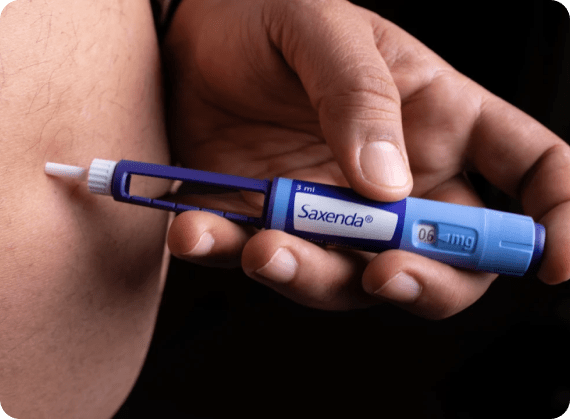How Does the Saxenda Injection Help with Weight Loss?
- sababashir576
- Dec 19, 2024
- 4 min read
The Saxenda injection is a popular weight-loss treatment that has been gaining attention for its effectiveness in helping individuals manage their weight. It is specifically designed for people who are struggling to lose weight and maintain a healthy lifestyle, especially when combined with a balanced diet and regular physical activity. Understanding how Saxenda Injections in Dubai works can provide better insights into its role in weight loss and why it has become a preferred option for many.
What Is Saxenda?
Saxenda is a prescription medication that contains the active ingredient liraglutide, a synthetic version of a hormone naturally produced in the body called glucagon-like peptide-1 (GLP-1). GLP-1 plays a significant role in regulating appetite, glucose metabolism, and insulin secretion. Saxenda mimics the effects of this hormone, making it effective for weight management.
Mechanism of Action
The primary way Saxenda promotes weight loss is by curbing appetite and helping individuals feel full sooner. It achieves this by working on the brain's appetite-regulating centers. Here’s a closer look at how it works:
Appetite Suppression: Saxenda acts on the hypothalamus, the part of the brain responsible for hunger and satiety signals. By influencing this region, Saxenda reduces overall appetite, which leads to a decrease in food intake.
Slower Gastric Emptying: Saxenda slows down the emptying of food from the stomach, making you feel fuller for longer after eating. This delayed gastric emptying contributes to the reduction in the frequency of meals and snacks throughout the day.
Increased Insulin Secretion: Saxenda also enhances insulin secretion in response to meals, helping regulate blood sugar levels. This can help prevent the body from storing excess fat due to fluctuating insulin levels.
Blood Sugar Regulation: By improving insulin sensitivity, Saxenda helps control blood sugar, which is crucial for managing weight and preventing fat accumulation. Stable blood sugar levels help avoid the energy crashes and cravings that can lead to overeating.

How Saxenda Is Used for Weight Loss
Saxenda is administered as a subcutaneous injection, meaning it is injected under the skin, typically once daily. It is available in pre-filled pens, which makes it convenient for at-home use. The injection is usually given in the thigh, abdomen, or upper arm. However, as with any medication, it’s important to follow the dosing instructions provided by your healthcare provider.
The treatment typically begins with a low dose, which is gradually increased over a few weeks. This helps reduce the likelihood of side effects, such as nausea or stomach discomfort. The recommended dose of Saxenda is typically around 3 mg per day, but the dosage may vary depending on the individual’s health status and weight loss goals.
Effectiveness of Saxenda for Weight Loss
Saxenda has been shown to be effective for weight loss when combined with a reduced-calorie diet and increased physical activity. Clinical studies have demonstrated that individuals using Saxenda can lose more weight compared to those relying solely on diet and exercise. On average, individuals who use Saxenda can expect to lose 5-10% of their initial body weight within 6 months, although results may vary.
It's important to note that Saxenda is not a magic pill. It works best as part of a comprehensive weight management program, which includes healthy eating habits, regular exercise, and behavioral changes. For those who are overweight or obese and have not had success with other weight loss methods, Saxenda can be a valuable tool in their weight loss journey.
Who Is Eligible for Saxenda?
Saxenda is typically prescribed to individuals who meet specific criteria, including:
Being overweight (BMI of 27 or higher) or obese (BMI of 30 or higher).
Having at least one weight-related health condition, such as type 2 diabetes, high blood pressure, or high cholesterol.
Being over the age of 18 and not pregnant or breastfeeding.
Saxenda is generally not recommended for individuals who have a history of certain health conditions, such as pancreatitis, gallbladder disease, or thyroid cancer. It's important to consult with a healthcare provider to determine if Saxenda is a suitable weight-loss option based on individual health conditions.
Side Effects of Saxenda
Like any medication, Saxenda can cause side effects. The most common side effects include nausea, vomiting, diarrhea, and stomach pain. These side effects typically subside as the body adjusts to the medication, especially when the dosage is gradually increased.
Serious side effects, though rare, can include pancreatitis (inflammation of the pancreas) and kidney problems. Individuals using Saxenda should monitor for any unusual symptoms and seek medical attention if necessary.
Conclusion
Saxenda offers a promising solution for those struggling with weight loss. By suppressing appetite, slowing gastric emptying, and helping regulate blood sugar levels, it can support long-term weight management efforts. However, it’s most effective when used in conjunction with lifestyle changes like proper nutrition and regular physical activity. As with any weight loss treatment, it’s essential to consult with a healthcare provider to determine if Saxenda is right for you and to develop a comprehensive weight loss plan tailored to your needs.
Ultimately, Saxenda provides a tool that can help individuals achieve their weight loss goals, but sustained success requires a holistic approach to health and well-being.



Comments